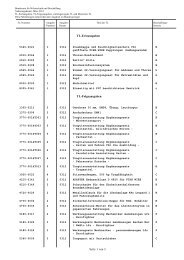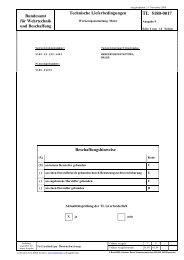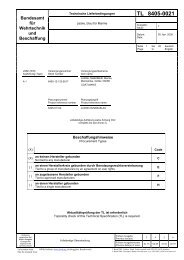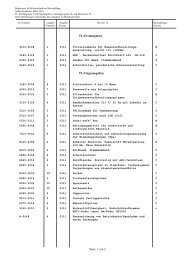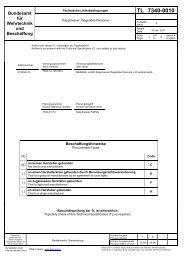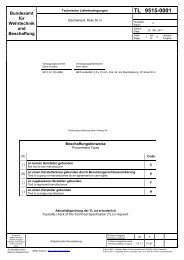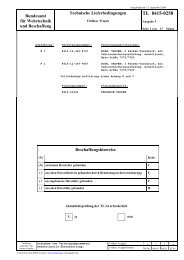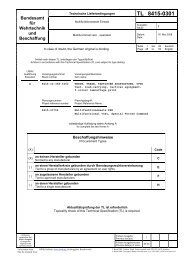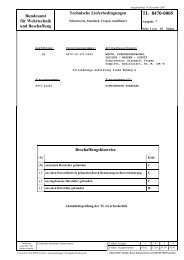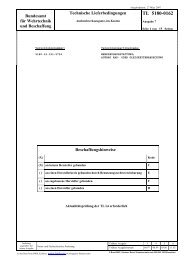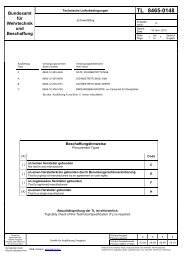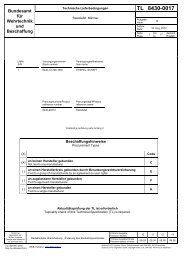TL 8410-0012 - Bundesamt für Wehrtechnik und Beschaffung
TL 8410-0012 - Bundesamt für Wehrtechnik und Beschaffung
TL 8410-0012 - Bundesamt für Wehrtechnik und Beschaffung
Sie wollen auch ein ePaper? Erhöhen Sie die Reichweite Ihrer Titel.
YUMPU macht aus Druck-PDFs automatisch weboptimierte ePaper, die Google liebt.
<strong>B<strong>und</strong>esamt</strong><br />
für<br />
<strong>Wehrtechnik</strong><br />
<strong>und</strong><br />
<strong>Beschaffung</strong><br />
Technische Lieferbedingungen <strong>TL</strong> <strong>8410</strong>-<strong>0012</strong><br />
Jackett für Soldatinnen (Marine)<br />
Jacket, women’s (Navy)<br />
Ausgabe:<br />
Issue:<br />
Datum:<br />
Date:<br />
5<br />
02. Dez. 2008<br />
Seite<br />
Page<br />
1<br />
19<br />
bis<br />
to<br />
18<br />
37<br />
deutsch<br />
English<br />
Ausführung<br />
Type<br />
Versorgungsnummer<br />
Stock number<br />
Versorgungsartikelname<br />
Item name<br />
A 1 <strong>8410</strong>-12-329-3951 JACKE, FRAUEN; Marine, Marineblau, Größe 36 - 168/84<br />
(JACKET, WOMEN’S) Navy, navy blue, size 36 - 168/84<br />
Planungsnummer:<br />
<strong>8410</strong>-01232<br />
Planungsbegriff:<br />
JACKE MAR WEIBLICHE SOLDATEN<br />
(JACKET, NAVY, FEMALE SOLDIERS)<br />
vollständige Auflistung siehe Anhang Cfor<br />
complete list see Annex C<br />
<strong>Beschaffung</strong>shinweise<br />
Procurement Types<br />
(X)<br />
(X)<br />
( )<br />
( )<br />
( )<br />
an keinen Hersteller geb<strong>und</strong>en<br />
Not tied to any manufacturer<br />
an einen Herstellerkreis geb<strong>und</strong>en durch Benutzungsrechtsvereinbarung<br />
Tied to a group of manufacturers by an agreement on user rights<br />
an zugelassene Hersteller geb<strong>und</strong>en<br />
Tied to approved manufacturers<br />
an einen Hersteller geb<strong>und</strong>en<br />
Tied to a single manufacturer<br />
Code<br />
C<br />
E<br />
F<br />
H<br />
Aktualitätsprüfung der <strong>TL</strong> ist erforderlich<br />
Topicality check of this Technical Specification (<strong>TL</strong>) is required.<br />
Änderung<br />
gegenüber der<br />
letzten Ausgabe<br />
Änderung in 2.1.5<br />
Change with<br />
respect to the<br />
previous issue<br />
Zu beziehen beim: BWB, Koblenz; www.bwb.org (Auftraggeber B<strong>und</strong>eswehr)<br />
May be obtained from:<br />
Frühere Ausgabe<br />
Previous issue(s)<br />
Frühere Ausgabemonate<br />
Previous date(s) of issue<br />
2 3 4<br />
10.94 07.06 11.08<br />
© B<strong>und</strong> 2008; Urheber: B<strong>und</strong>, Schutzvermerk nach DIN ISO 16016 beachten<br />
© B<strong>und</strong> 2008; Originator: B<strong>und</strong>, copyright note i.a.w. DIN ISO 16016 to be observed
Seite 2 <strong>TL</strong> <strong>8410</strong>-<strong>0012</strong><br />
NORMATIVE VERWEISUNGEN<br />
Diese <strong>TL</strong> enthalten durch datierte <strong>und</strong> <strong>und</strong>atierte Verweisungen Festlegungen aus anderen Dokumenten<br />
(Normen, <strong>TL</strong> usw.). Diese Dokumente sind an den jeweiligen Stellen im Text zitiert<br />
(Normative Verweisung). Alle in diesen <strong>TL</strong> zitierten Dokumente sind nachstehend aufgeführt.<br />
Bei datierten Verweisungen haben spätere Änderungen oder Überarbeitungen der zitierten Dokumente<br />
für die vorliegenden <strong>TL</strong> erst dann Gültigkeit, wenn sie in die vorliegenden <strong>TL</strong> eingearbeitet<br />
sind. Bei <strong>und</strong>atierten Verweisungen gilt jeweils die zum Zeitpunkt des Vertragsabschlusses<br />
gültige Ausgabe der zitierten Dokumente.<br />
AQAP-2131<br />
DIN 53894-2<br />
DIN 55350-18<br />
NATO-Qualitätssicherungsanforderungen für Endprüfung<br />
Prüfung von Textilien; Bestimmung der Maßänderung von<br />
textilen Flächengebilden, Dämpfen auf Bügelmaschinen<br />
Begriffe der Qualitätssicherung <strong>und</strong> Statistik; Begriffe zu<br />
Bescheinigungen über die Ergebnisse von Qualitätsprüfungen;<br />
Qualitätsprüf-Zertifikate<br />
DIN 55510-3 Verpackung - Modulare Koordination im Verpackungswesen -<br />
Teil 3: Regeln <strong>und</strong> Maße<br />
DIN 61400<br />
Nähmaschinen – Nähstichtypen – Einteilung <strong>und</strong> Begriffe<br />
DIN EN ISO 3175-1 Textilien – Chemischreinigung <strong>und</strong> Nachbehandlung – Teil 1:<br />
Beurteilung der Eignung von Textilien <strong>und</strong> Kleidungsstücken<br />
für die Reinigung<br />
RAL 840 HR<br />
<strong>TL</strong> 8305-0011<br />
<strong>TL</strong> 8305-0037<br />
<strong>TL</strong> 8305-0044<br />
<strong>TL</strong> 8305-0103<br />
<strong>TL</strong> 8305-0186<br />
<strong>TL</strong> 8305-0216<br />
<strong>TL</strong> 8305-0292<br />
<strong>TL</strong> 8310-0004<br />
<strong>TL</strong> 8315-0003<br />
<strong>TL</strong> 8315-0040<br />
<strong>TL</strong> 8315-0046<br />
<strong>TL</strong> 8315-0048<br />
<strong>TL</strong> 8320-0003<br />
Farbregister der klassischen Farben des RAL<br />
Gewebe aus Naturfasern, Chemiefasern <strong>und</strong> deren Mischgespinsten,<br />
sowie daraus gefertigtes Bekleidungs-, Wäsche<strong>und</strong><br />
Ausrüstungsstücke (Allgemeine Bedingungen)<br />
Leibfutter für Uniformen<br />
Baumwollgewebe (Twill)<br />
Uniformstoff für die Ausgehuniform der Marine<br />
Stoff für Taschenfutter aus Polyamid<br />
Leinenverb<strong>und</strong>ener Unterkragenfilz<br />
Front-Fixiereinlage<br />
Polyester-Nähzwirne<br />
Knöpfe aus Kunststoff<br />
Schulterpolster<br />
Bänder aus Naturfasern <strong>und</strong> Chemiefasern<br />
Uniformknöpfe Metall für Marine<br />
Wattelinen <strong>und</strong> Schaumstoffvlies<br />
Bezugsquellen:<br />
AQAP, <strong>TL</strong><br />
DIN, DIN EN ISO<br />
RAL 840 HR<br />
<strong>B<strong>und</strong>esamt</strong> für <strong>Wehrtechnik</strong> <strong>und</strong> <strong>Beschaffung</strong>,<br />
Postfach 30 01 65, 56057 Koblenz,<br />
www.bwb.org (Auftraggeber B<strong>und</strong>eswehr)<br />
Beuth Verlag GmbH, 10772 Berlin, www.beuth.de<br />
RAL, Siegburger Str. 39, 53757 Sankt Augustin<br />
E-Mail: RAL-Colours@RAL-gGmbH.de
<strong>TL</strong> <strong>8410</strong>-<strong>0012</strong> Seite 3<br />
1 ALLGEMEINES<br />
1.1 Anwendungsbereich<br />
Das Jackett ist ein Teil der Dienst- <strong>und</strong> Ausgehbekleidung der Soldatinnen der<br />
Marine.<br />
Kurzbeschreibung<br />
Zweireihig, 3 Knopfpaare, spitzes Fasson, Vorderteilteilungsnaht, 2 gerade eingearbeitete<br />
Seitentaschen mit Patten, hohle Kanten, Rücken mit Mittelnaht,<br />
2 Innentaschen mit Stoffpaspel, zweiteiliger Ärmel.<br />
1.2 Allgemeine technisch-organisatorische Forderungen<br />
Nach den <strong>TL</strong> 8305-0011<br />
Insbesondere wird auf die Forderungen zum Ges<strong>und</strong>heits-, Betriebs- <strong>und</strong> Umweltschutz<br />
hingewiesen.<br />
1.3 Umweltverträglichkeit<br />
Nach den <strong>TL</strong> 8305-0011.<br />
2 TECHNISCHE FORDERUNGEN<br />
2.1 Materialien Verwendungszweck Farbe<br />
2.1.1 Oberstoff<br />
nach den <strong>TL</strong> 8305-0103 Uniformstoff<br />
für die Ausgehuniform<br />
der Marine<br />
Ausführung a<br />
2.1.2 Leibfutter für Uniformen<br />
nach den <strong>TL</strong> 8305-0037<br />
2.1.3 Taschenfutter<br />
nach den <strong>TL</strong> 8305-0044 Baumwolle<br />
(Twill) oder nach den <strong>TL</strong><br />
8305-0186 Stoff für Taschenfutter<br />
aus Polyamid<br />
Qualitätsnachweis: Qualitätsprüf-Zertifikat<br />
DIN 55350-18–<br />
4.1.2<br />
2.1.4 Front-Fixiereinlage<br />
nach den <strong>TL</strong> 8305-0292<br />
VT, Kantenbesetzen, Doppelpaspel<br />
für Innentasche, RT, Oberkragen,<br />
Ober- <strong>und</strong> Unterärmel,<br />
Kragensteg, Seitentaschenpatten,<br />
Seitentaschenpaspel,<br />
Für Vorderteil-, Rückenteil-,<br />
Patten- <strong>und</strong> Ärmelfutter sowie<br />
Seiten- <strong>und</strong> Innentaschenbesetzen<br />
Seiten- <strong>und</strong> Innentaschenbeutel<br />
<strong>und</strong> Tascheneckenverstärkungen<br />
Marineblau<br />
Stahlblau<br />
RAL 5011<br />
als Anhalt<br />
Schwarzgrau<br />
RAL<br />
7021 als<br />
Anhalt<br />
2.1.4.1 Ausführung B2, mittel-schwer VT Schwarz<br />
2.1.4.2 Ausführung A2, leicht für Besetzen (Oberteil) <strong>und</strong><br />
Rückenhalslochspiegel, Knopf<strong>und</strong><br />
Knopflochstreifen, Oberkragen,<br />
Taschenpatten <strong>und</strong> Ärmelsaum.<br />
Schwarz<br />
2.1.5 Einlage<br />
waschbar bei 40 ° C, handelsüblich,<br />
wie Haareinlage, Bindung:<br />
L 1/1, 195 g/m²; reinigungsbeständig<br />
gemäß Obermaterial<br />
Material: 18 % HZ, 12 % Wo,<br />
70 % PES<br />
Plack<br />
Graubraunmeliert
Seite 4 <strong>TL</strong> <strong>8410</strong>-<strong>0012</strong><br />
2.1 Materialien Verwendungszweck Farbe<br />
Schuss: PES<br />
Kette: PES, HZ, WO<br />
wie Artikel KO 276e der Fa.<br />
Freudenberg Vliesstoffe KG oder<br />
Artikel gleichwertige Art<br />
Maßänderung in Kette <strong>und</strong><br />
Schuss ≤ 1,5 %:<br />
- nach DIN 53894-2 Prüfung<br />
Dämpfen mit Bügelmaschinen <strong>und</strong><br />
- nach DIN EN ISO 3175-1 Prüfung<br />
der Chemischen-Reinigung<br />
Farbechtheiten dem Oberstoff<br />
entsprechend (außer Licht-,<br />
Wasch- <strong>und</strong> Alkaliechtheit)<br />
Qualitätsnachweis: Qualitätsprüf-Zertifikat<br />
DIN 55350-18-<br />
4.1.2<br />
2.1.6 Wattelinen <strong>und</strong> Schaumstoffvlies<br />
nach den <strong>TL</strong> 8320-0003,<br />
Ausführung C<br />
2.1.7 Unterkragenfilz<br />
nach den <strong>TL</strong> 8305-0216 Leinenverb<strong>und</strong>ener<br />
Unterkragenfilz,<br />
Ausführung A 3<br />
2.1.8 Schulterpolster<br />
nach den <strong>TL</strong> 8315-0040 Schulterpolster<br />
für Uniformjacken<br />
<strong>und</strong> –mäntel (weibliche Soldaten),<br />
Ausführung C<br />
Qualitätsnachweis: Qualitätsprüf-Zertifikat<br />
DIN 55350-18-<br />
4.1.1<br />
2.1.9 Uniformknöpfe<br />
nach den <strong>TL</strong> 8315-0048 Uniformknöpfe<br />
Metall für Marine<br />
Ärmelkugeleinlage<br />
Unterkragen<br />
1 Paar<br />
Schwarz<br />
Blaumeliert<br />
RAL 5004<br />
als Anhalt<br />
3 Stück 21 K für rechtes Vorderteil<br />
3 Stück 21 N für linkes Vorderteil<br />
Goldfarbig<br />
2.1.10 Knöpfe<br />
nach den <strong>TL</strong> 8315-0003<br />
Knöpfe aus Kunststoff<br />
2.1.11 Bänder aus Naturfasern <strong>und</strong><br />
Chemiefasern<br />
2.1.11.1 Aufhängerband<br />
nach den <strong>TL</strong> 8315-0046-201<br />
2.1.11.2 Eckenband<br />
nach den <strong>TL</strong> 8315-0046-203<br />
1 Stück Oberbekleidungsknopf<br />
19 mm<br />
Aufhänger<br />
Eckenband für Sicherung des<br />
Rückenteilarmloches bis einschließlich<br />
6 bis 8 cm Seitennaht.<br />
Wahlweise wird auch handelsübliches<br />
Lisierband zugelassen<br />
Das Rückenteilarmloch<br />
kann auch wahlweise mit Nadelband<br />
eingehalten werden.<br />
Schwarz<br />
Schwarz
<strong>TL</strong> <strong>8410</strong>-<strong>0012</strong> Seite 5<br />
2.1 Materialien Verwendungszweck Farbe<br />
2.1.11.3 Eckenschrägband<br />
nach den <strong>TL</strong> 8315-0046-205<br />
2.1.11.4 Bügelklebeband<br />
nach den <strong>TL</strong> 8315-0046-208<br />
Eckenschrägband für Sicherung<br />
der Vorderteilschulternaht <strong>und</strong><br />
des Seitenteilarmloches. Für<br />
das Seitenteilarmloch wird<br />
wahlweise auch Front-Fixiereinlage,<br />
leicht zugelassen.<br />
Breite: 15 mm<br />
Bügelklebeband zur Sicherung<br />
der vorderen Kanten, des Klappenbruchs<br />
<strong>und</strong> zum Fixieren des<br />
Placks.<br />
Breite: ca. 20 mm<br />
2.1.12 Nähmittel<br />
nach den <strong>TL</strong> 8310-0004 Polyester-Nähzwirne<br />
26 tex x 2 (Nm 40/2) Umspinnungs-Nähzwirn<br />
oder 20 tex x 3<br />
(Nm 50/3) Spinnfaser/Umspinnungsnähzwirn<br />
Farbpassend<br />
zum<br />
Oberstoff<br />
20 tex x 2 (Nm 50/2) Umspinnungs-Nähzwirn<br />
oder 14 tex x 3<br />
(Nm 70/3) aus Spinnfaser<br />
8,4 tex x 2 (Nm 120/3) Bauschgarn<br />
14 tex x 3 (Nm 70/3) Spinnfaser<br />
oder 20 tex x 2 (Nm 50/2)<br />
Umspinnungs-Nähzwirn<br />
33 tex x 3 (Nm 30/3) Spinnfaser<br />
oder 33 tex x 3 (Nm 30/3)<br />
Umspinnungszwirn<br />
Schließnähte<br />
Umstechen<br />
für Knopflöcher<br />
Gimpe <strong>und</strong> Knopfansatz, per<br />
Handarbeit<br />
Knopfansatz, maschinell<br />
Umspinnung<br />
2.2 Schnittteile <strong>und</strong> Verarbeitungshinweise<br />
Der Schnittkonstruktion sind die Maßtabelle (Anhang A), die Schnittteile <strong>und</strong> die<br />
Verarbeitungshinweise unter 2.2 <strong>und</strong> die Bilder (Bild 1 bis Bild 3 als Anhalt)<br />
zugr<strong>und</strong>e zu legen. Fertigmaße gemäß 2.2 <strong>und</strong> der Maßtabelle (Anhang A) sind verbindlich.<br />
Die Proportionen des abgebildeten Versorgungsartikels sind schnitt- <strong>und</strong><br />
nähtechnisch analog den Bildern sicherzustellen.<br />
Alle Schnittteile müssen in Kettrichtung zugeschnitten werden. Eine wechselseitige<br />
Schnittrichtung wird zugelassen. Alle Teile eines Jacketts sind jedoch in der<br />
gleichen Schnittrichtung zuzuschneiden. Markierungsbohrlöcher sind nicht zulässig.<br />
Die Vorderteile sind frontfixiert. Fixierbedingungen siehe Anhang B.<br />
Nahtzugaben müssen vom Auftragnehmer so individuell bestimmt werden, dass alle<br />
Nähte, wenn nicht anders angegeben, voll mit 1,0 cm gefasst sind. Alle offenen<br />
Schnittkanten sind mit dem Stichtyp 504 nach DIN 61400 umstochen. Alle offenen<br />
Nahtenden sind mit dem Stichtyp 301/304 verriegelt. Die Nähte dürfen keine Kräuselungen<br />
des Nähgutes aufweisen.<br />
Teile Merkmale Fertigmaße<br />
(cm )/<br />
Bilder<br />
2.2.1 Vorderteile <strong>und</strong> Zubehör<br />
2.2.1.1 Vorderteile<br />
2.2.1.1.1 2 Vorderteile Oberstoff mit Vorderteil-Teilungsnaht<br />
(Prinzessnaht)<br />
Die Naht ist auszubügeln.<br />
Stichtyp<br />
DIN<br />
61400<br />
Bild 1 301
Seite 6 <strong>TL</strong> <strong>8410</strong>-<strong>0012</strong><br />
Teile Merkmale Fertigmaße<br />
(cm )/<br />
Bilder<br />
2.2.1.1.2 2 Vorderteileinlagen<br />
Front-Fixiereinlage, mittel-schwer<br />
Ausführung B<br />
2<br />
Stichtyp<br />
DIN<br />
61400<br />
Gegenüber den Schnittkanten des<br />
Oberstoffes müssen die Schnittkanten<br />
der Fixiereinlage wie folgt<br />
zurückgesetzt sein:<br />
Vorderteilkante<br />
12 mm<br />
Schulter- <strong>und</strong> Seitennaht 15 mm<br />
Saum<br />
30 mm<br />
Alle übrigen Schnittkanten 3 mm<br />
Die vorderen Kanten sind mit ausgezogenem<br />
Klebeschrägband zu verarbeiten.<br />
2.2.1.1.3 2 Kantenbesetzen<br />
Oberstoff <strong>und</strong> Front-Fixiereinlage,<br />
leicht, Ausführung A<br />
2<br />
Die Fixiereinlage muss bis 5 cm<br />
unterhalb der Oberweitenlinie reichen<br />
<strong>und</strong> ist an allen Nahtkanten<br />
0,3 cm zurückzusetzen.<br />
Fertigbreite:<br />
- an der Spiegelnaht 2,5-3,0<br />
- in Höhe des obersten Knopfes 8,5<br />
- an der Saumkante ca. 8,0<br />
Das Kantenbesetzen ist vom Halslochring<br />
der Länge des Placks entsprechend<br />
anzuschlagen.<br />
2.2.1.2 Seitentaschen<br />
2.2.1.2.1 2 Seitentaschenpatten<br />
2.2.1.2.2 2 Seitentaschenpattenfutter<br />
2.2.1.2.3 4 Seitentaschenpaspel<br />
2.2.1.2.4 2 Seitentaschenbesetzen<br />
Oberstoff<br />
Fertige Länge:<br />
Fertige Breite:<br />
Leibfutter<br />
Einlage: Frontfixiereinlage,<br />
leicht, Ausführung A 2<br />
Oberstoff<br />
Die Paspel sind mit Webkante zu<br />
schneiden.<br />
Schnittbreite: ca. 5,5<br />
Schnittlänge: 19,0-20,0<br />
Leibfutter<br />
Schnittbreite: ca. 5,0 cm<br />
Schnittlänge: ca. 19,0 cm<br />
15,0<br />
5,5<br />
2.2.1.2.5 2 Seitentaschenbeutel<br />
Taschenfutter<br />
Fertige Tiefe: 18,0<br />
2.2.1.2.6 2 Seitentaschenverstärkungsstreifen<br />
Front-Fixiereinlage, leicht<br />
Breite:<br />
Sie dienen zur Verstärkung der Taschenecken<br />
<strong>und</strong> sind in die Seitennaht<br />
zu führen.<br />
4,0
<strong>TL</strong> <strong>8410</strong>-<strong>0012</strong> Seite 7<br />
Teile Merkmale Fertigmaße<br />
(cm )/<br />
Bilder<br />
2.2.1.2.7 Verarbeitung Taschenlage bei allen Größen 8 cm<br />
unterhalb der Taillenlinie<br />
Eingriffslänge:<br />
Bild 2<br />
15,0<br />
Stichtyp<br />
DIN<br />
61400<br />
Die Taschenpatten sind mit dem Pattenfutter<br />
zu verstürzen.<br />
Fertigbreite der Paspel:<br />
Die Paspel sind auszubügeln <strong>und</strong><br />
durch die Naht zu steppen. Paspelautomat<br />
zugelassen.<br />
Die Einschnittwinkel an den Eingriffsecken<br />
sind rechtwinklig zu<br />
diesen von links abzunähen, offene<br />
Schnittkanten sind zuvor einzuschlagen.<br />
Die vorgefertigte Taschenpatte<br />
ist einzulegen <strong>und</strong> der<br />
Taschenbeutel zu schließen. Das<br />
Schließen der Tasche sowie die Stichelung<br />
ist von links durch den<br />
Taschenbeutel unmittelbar neben der<br />
vorhandenen Naht auszuführen. Zusätzlich<br />
sind die Eingriffsecken<br />
von links sauber zu versticheln<br />
(3fache Stepptour).<br />
2.2.1.3 Plack Einlage, handelsüblich<br />
Kettfadenverlauf wie Oberstoff;<br />
Verlauf des Placks 3,0 cm unterhalb<br />
des Armloches, oberhalb des Brustpunktes<br />
bis in halbe Höhe des Klappenbruches.<br />
An der Schulternaht ist<br />
der Plack 2 cm breit zurückzuschneiden.<br />
Im Armloch ist der Plack<br />
beim Einnähen der Ärmel mitzufassen.<br />
Der Plack ist 1 cm von dem<br />
Klappenbruch mit Klebeband kurzhaltend<br />
zu sichern. Das Klebeband ist<br />
am Plack mit Zick-Zack-Doppelsteppstichnaht<br />
vorgenäht. Unten bleibt<br />
der Plack lose <strong>und</strong> darf nicht angenäht<br />
werden. Unterkante in Wellenform<br />
zugeschnitten.<br />
0,5-0,6<br />
301<br />
301<br />
301<br />
301<br />
2.2.1.4 2 Futtervorderteile<br />
Leibfutter mit Seitenabnäher oder<br />
Seitenteil<br />
Der Brustabnäher ist zur vorderen<br />
Kante zu führen.<br />
Länge:<br />
An der Saumkante muss das Futter eine<br />
ca. 1 cm tiefe Falte aufweisen. Abstand<br />
des Futters von der Saumkante:<br />
ca. 6,0-<br />
7,0<br />
ca. 1,5<br />
2.2.1.5. Innentaschen<br />
2.2.1.5.1 2 Innentaschen Baumwollgewebe (Twill) oder Taschenfutter<br />
aus Polyamid<br />
2 Doppelpaspel Oberstoff<br />
Paspelbreite:<br />
Eingriffslänge:<br />
Mittlere Tiefe:<br />
Lage: 2,0 cm unterhalb des mittleren<br />
Knopfes/Knopfloches<br />
Abstand von der fertigen vorderen<br />
Futterkante:<br />
0,4<br />
ca. 14,0<br />
17,0<br />
ca. 1,5
Seite 8 <strong>TL</strong> <strong>8410</strong>-<strong>0012</strong><br />
Teile Merkmale Fertigmaße<br />
(cm )/<br />
Bilder<br />
2.2.1.5.2 2 Taschenbesetzen<br />
Innentasche, Leibfutter<br />
Schnittbreite: 6,0 cm<br />
Stichtyp<br />
DIN<br />
61400<br />
2.2.1.5.3 2 Innentaschenverstärkungsstreifen<br />
Baumwollgewebe (Twill) oder Taschenfutter<br />
aus Polyamid<br />
Sie dienen zur Verstärkung der Eingriffsecken<br />
<strong>und</strong> sind ab Besetzen<br />
anzuschlagen.<br />
2.2.2 Rückenteile <strong>und</strong> Zubehör<br />
2.2.2.1 2 Rückenteile Oberstoff<br />
mit Mittelnaht<br />
Die Rückenmittelnaht ist auszubügeln.<br />
2.2.2.2 2 Schulterabnäher<br />
2.2.2.3 Einlage für<br />
Rückenhalslochspiegel<br />
Die Abnäher sind einzuschneiden <strong>und</strong><br />
auszubügeln. Das Rückenteilarmloch<br />
kann auch mit Nadelband anstatt mit<br />
Eckenband eingehalten werden.<br />
Saumeinschlagbreite:<br />
Front-Fixiereinlage, leichte Ausführung<br />
A 2<br />
Breite:<br />
Die Einlage ist an allen Nahtkanten<br />
0,3 cm zurückzusetzen.<br />
Bild 2<br />
3,0<br />
6,0<br />
2.2.2.4 Rückenfutter Leibfutter<br />
Das Rückenfutter muss eine Mittelfalte<br />
von ca. 1,5 cm Tiefe erhalten.<br />
Saum:<br />
Vorderteil- <strong>und</strong> Rückenfutter müssen<br />
eine Saumfalte von ca. 1,0 cm Tiefe<br />
erhalten.<br />
Abstand des Leibfutters von der<br />
Saumkante: ca. 1,5<br />
2.2.3 Kragen<br />
2.2.3.1 1 Unterkragen leinenverb<strong>und</strong>ener Unterkragenfilz<br />
2.2.3.2 1 Oberkragen Oberstoff<br />
Der Unterkragen ist mit einer Zick-<br />
Zack-Maschine aufzunähen.<br />
farbpassend zum Oberstoff<br />
2.2.3.3 Einlage für<br />
Oberkragen<br />
Front-Fixiereinlage, leicht<br />
Die Einlage ist an allen Nahtkanten<br />
des Oberkragens <strong>und</strong> Kragensteges<br />
0,3 cm zurückzusetzen.<br />
Kragenmaße:<br />
2,5<br />
Stehfußbreite:<br />
Umfallbreite (in der hinteren Mitte): 2,8<br />
2.2.3.4 Verarbeitung Der Oberkragen ist mit Kragensteg<br />
zu fertigen. Nahtabstand vom Kragenbruch:<br />
ca. 1,0
<strong>TL</strong> <strong>8410</strong>-<strong>0012</strong> Seite 9<br />
Teile Merkmale Fertigmaße<br />
(cm )/<br />
Bilder<br />
Die Ansatznaht ist beidseitig auszusteppen<br />
Der Oberkragen ist mit<br />
einer Zick-Zack-Maschine auf den<br />
Unterkragen aufzustoßen. Die Spiegelnaht<br />
kann mit der Maschine genäht<br />
<strong>und</strong> ausgebügelt oder mit der<br />
Hand staffiert <strong>und</strong> angestoßen werden.<br />
Der Oberkragen ist an der Crochetecke<br />
1,5 cm umzulegen <strong>und</strong> sauber<br />
anzustaffieren. Das Futter ist mit<br />
der unteren Kante des Oberkragenstegs<br />
zu verstürzen <strong>und</strong> überzubügeln.<br />
Ober- <strong>und</strong> Unterkragen sind in<br />
der unteren Oberkragenstegnaht mittels<br />
Steppstich miteinander zu verbinden.<br />
Stichtyp<br />
DIN<br />
61400<br />
301<br />
301<br />
301<br />
301<br />
2.2.3.5 1 Aufhänger Aufhängerband<br />
2.2.4 Ärmel<br />
2.2.4.1 2 Oberärmel Oberstoff<br />
2.2.4.2 2 Unterärmel Oberstoff<br />
Fertige Länge:<br />
Er ist auf der Mitte <strong>und</strong> unteren<br />
Kante des Oberkragenstegs vorzunähen<br />
<strong>und</strong> von außen zu versticheln.<br />
Kurznahtautomat ist zugelassen.<br />
Saumeinschlag:<br />
Handweite (je nach Körperhöhe):<br />
8,0<br />
4,0<br />
13,5-15,0<br />
301/<br />
504<br />
2.2.4.3 2 Oberärmelfutter<br />
2.2.4.4 2 Unterärmelfutter<br />
2.2.4.5 Ärmelsaumeinlage<br />
Leibfutter<br />
Leibfutter<br />
Front-Fixiereinlage, leicht, Ausführung<br />
A 2<br />
Schnittbreite: ca. 6,0 cm<br />
2.2.4.6 Verarbeitung Der Saumeinschlag ist an den Ärmelnähten<br />
anzuschlagen. Das Ärmelfutter<br />
ist mit dem Saum zu verstürzen<br />
<strong>und</strong> 8 cm bis 10 cm an die hintere<br />
Ärmelnaht anzuschlagen. Das Ärmelfutter<br />
ist im Armloch zu staffieren.<br />
In der Unterärmelpartie, von<br />
der vorderen Ärmelmitte bis ca.<br />
3 cm unter der Ellenbogennaht, kann<br />
das Ärmelfutter mit der Maschine<br />
verstürzt werden. Die Ärmelfutternaht<br />
ist im Armloch anzuschlagen.<br />
Zur Erreichung eines guten Ärmelüberganges<br />
ist in der Kugel Watteline<br />
einzulegen. Schnittlänge des<br />
Wattelinestreifens: ca. 25,0 cm<br />
Schnittbreite (Wollwatteline doppelt):<br />
ca. 4,0 cm
Seite 10 <strong>TL</strong> <strong>8410</strong>-<strong>0012</strong><br />
Teile Merkmale Fertigmaße<br />
(cm )/<br />
Bilder<br />
2.2.5 Kantenübertritt Rechtes <strong>und</strong> linkes Teil: 7,0<br />
Stichtyp<br />
DIN<br />
61400<br />
2.2.5.1 Position Knopflöcher<br />
<strong>und</strong> Knöpfe<br />
Position vertikal:<br />
Das obere Knopfpaar liegt bei allen<br />
Größen 8,5 cm oberhalb der Taillenlinie,<br />
das untere Knopfpaar in Taschenhöhe.<br />
In der Mitte ist das<br />
dritte Knopfpaar zu platzieren.<br />
Position horizontal:<br />
Die drei Knopfpaare sind jeweils<br />
5,0 cm von der vorderen Mitte entfernt.<br />
Knopflochlage entsprechend der<br />
Knopfstellung:<br />
Abstand von der vorderen Kante:<br />
Knopflochlänge:<br />
Am rechten Vorderteil muss der<br />
mittlere Knopf einen Gegenknopf<br />
erhalten. Im linken Vorderteil ist<br />
hierfür ein Knopfloch einzuarbeiten.<br />
2,0<br />
2,5<br />
2.2.5.2 Knopflöcher Sämtliche Knopflöcher sind als Augenknopflöcher<br />
mit Querriegeln <strong>und</strong><br />
Vorpass aus Gimpe einzuarbeiten. Es<br />
ist nur eine nachherschneidende<br />
Knopflochmaschine zu verwenden. Die<br />
Fadenenden sind mit Maschinenriegel<br />
ausreichend zu sichern.<br />
2.2.5.3 Knöpfe Stichzahl:<br />
Maschinell mindestens 10 Stiche je<br />
Öse<br />
Manuell mindestens 5 Stiche je<br />
Öse mit Doppelfaden.<br />
Die Fadenenden sind zu verstechen.<br />
2.2.6 Fasson<br />
Die Fassonbreite ist 3,5 cm unterhalb<br />
des Halslochringes rechtwinklig<br />
zum Klappenbruch zu messen.<br />
Brustumfang 84 & 88 92 & 96 100 & 104<br />
Fassonbreite 8,0 8,5 9,0<br />
Abstand der Crochetecke<br />
vom Klappenbruch<br />
Höhe der Fassonspitze von der Winkellinie<br />
jeweils:<br />
Die Fassonkanten sind leicht gewölbt<br />
<strong>und</strong> die Fassonspitzen nicht<br />
zu stumpf auszuarbeiten.<br />
2.2.7 Kragen Kragen <strong>und</strong> Fasson stoßen aneinander.<br />
Kragenbreite am Fassoneinschnitt:<br />
4,0 cm<br />
Die äußere Kragenbreite verläuft<br />
vom Fassoneinschnitt zunächst gerade,<br />
dann in leicht gewölbtem Verlauf<br />
zur Kragenmitte.<br />
3,0 3,25 3,5<br />
2,5
<strong>TL</strong> <strong>8410</strong>-<strong>0012</strong> Seite 11<br />
Teile Merkmale Fertigmaße<br />
(cm )/<br />
Bilder<br />
2.2.8 Nähte Sämtliche Nähte sind in Doppelsteppstich<br />
auszuführen.<br />
Sämtlich Nähte sind auszubügeln.<br />
Alle verdeckten Nähte (Schließnähte)<br />
können alternativ mit Doppelkettenstich<br />
genäht werden.<br />
Die Nahtenden sind ausreichend zu<br />
sichern.<br />
Stichtyp<br />
DIN<br />
61400<br />
301<br />
304<br />
Stichdichte:<br />
- Schließnähte 5 Stiche/cm<br />
- Steppnähte 4 bis 5 Stiche/cm<br />
Alle offenen Schnittkanten sind zu<br />
umstechen mit Überwendlichstich<br />
(4 Stiche/cm)<br />
504<br />
An der Seitennaht von Rücken- <strong>und</strong><br />
Seitenteil, sowie im oberen Bereich<br />
der Ellenbogennaht (bis Ellenbogen)<br />
von Ober- <strong>und</strong> Unterärmel ist jeweils<br />
ein Nahteinschlag von 2 cm<br />
zuzugeben.<br />
2.3 Kontrollmaße (gemäß Anhang A)<br />
Die Überprüfung muss bei geschlossenem Versorgungsartikel erfolgen.<br />
Zulässige Toleranz der Fertigmaße: -0/+2 %<br />
Kontrollmaße am fertigen Stück<br />
Oberweitenlinie: ½ Brustumfang laut Tabelle + 9,0 cm<br />
Unterweitenlinie: ½ Taillenumfang laut Tabelle + 8,0 cm<br />
Hüftweitenlinie: ½ Hüftumfang laut Tabelle + 6,0 cm<br />
2.4 Kennzeichnung<br />
Das Anbringen von Marken- <strong>und</strong> Firmenlogos ist nicht gestattet. Die Kennzeichnung<br />
erfolgt nur gemäß den, in den jeweils gültigen <strong>TL</strong> festgelegten Vorgaben.<br />
Das Kennzeichnungsetikett nach den <strong>TL</strong> 8305-0011 ist auf dem Besetzen der linken<br />
Innentasche aufzunähen. Das Schlaufenetikett mit der Größenbezeichnung ist in der<br />
Mitte des Rückenteils mit der inneren Anschlagnaht des Oberkragens mitzunähen.<br />
Auf dem Kennzeichnungsetikett sind folgende Ergänzungen (eingewebt oder aufgedruckt):<br />
- 1. Stelle „DEU“ (Kurzbezeichnung für Deutschland)<br />
- Name des Auftragnehmers<br />
- Größen Bsp.: 36 – 168/84 (Anhang A)<br />
- Versorgungsnummern (Anhang C)<br />
- ASD-Nummern (Anhang C)<br />
- Materialzusammensetzung:<br />
„Oberstoff: 100 % Schurwolle“, Futter: je nach Materialeinsatz „100 % Viskose“<br />
oder. „100 % Cupro“<br />
sowie die nachfolgenden Symbole für die Pflegebehandlung von Textilien:
Seite 12 <strong>TL</strong> <strong>8410</strong>-<strong>0012</strong><br />
3 QUALITÄTSSICHERUNG<br />
3.1 Qualitätsprüfungen<br />
Nach den <strong>TL</strong> 8305-0011<br />
3.2 Qualitätssicherungsbedingungen<br />
Der Auftragnehmer verpflichtet sich, auf der Gr<strong>und</strong>lage der in den technischen Unterlagen<br />
festgelegten Qualitätssicherungsforderungen, Maßnahmen entsprechend den<br />
Bestimmungen der AQAP-2131, NATO-Qualitätssicherungsanforderungen für Endprüfung<br />
zur Sicherstellung der vertragsgemäßen Beschaffenheit der Leistung durchzuführen.<br />
Diese Qualitätssicherungsmaßnahmen sind produktbezogen darzulegen. Der Umfang<br />
dieser Maßnahmen hat sich an den mit der Herstellung verb<strong>und</strong>enen Risiken zu orientieren.<br />
Bescheinigung der Prüfergebnisse<br />
Die Einhaltung der in diesen Technischen Lieferbedingungen gestellten technischen<br />
Forderungen an den Gegenstand dieser <strong>TL</strong> ist vom Auftragnehmer durch ein Qualitätsprüf-Zertifikat<br />
nach DIN 55350-18-4.2.2 zu bestätigen, das dem Auftraggeber<br />
vorzulegen ist. Auf Verlangen ist diesem eine Ausfertigung zu überlassen.<br />
3.3 Güteprüfung*)<br />
Nach den <strong>TL</strong> 8305-0011<br />
*) Sofern die <strong>Beschaffung</strong> durch eine Bekleidungsgesellschaft erfolgt,<br />
gilt nachfolgende Regelung:<br />
Die Güteprüfung ist Bestandteil des Vertrages zwischen Bekleidungsgesellschaft<br />
<strong>und</strong> Auftragnehmer.<br />
Darüber hinaus behält sich der B<strong>und</strong> im Rahmen der Qualitätssicherung im Einzelfall<br />
vor, vom Auftragnehmer über die Bekleidungsgesellschaft Mustermaterialien<br />
für Prüfzwecke bzw. Prüfzertifikate anzufordern.<br />
4 VERPACKUNG<br />
4.1 Aufmachung<br />
Das Jackett ist abzubügeln <strong>und</strong> das Futter zu glätten. Das Jackett ist entsprechend<br />
der Schachtelgröße zu legen. Knöpfe sind zu schließen.<br />
4.2 Gr<strong>und</strong>packung – Versandpackung<br />
Nach den <strong>TL</strong> 8305-0011, Abschnitt Bekleidungs-, Wäsche- <strong>und</strong> Ausrüstungsstücke.<br />
Je 10 Jacketts gleicher Versorgungsnummer sind rüttelfest zu verpacken.<br />
4.2.1 Außenmaße der Versandpackung nach DIN 55510-3 (Maximalmaße)<br />
4.2.2 Verschluss<br />
1.000 mm x 600 mm x 150 mm<br />
Nach den <strong>TL</strong> 8305-0011, Abschnitt Bekleidungs-, Wäsche- <strong>und</strong> Ausrüstungsstücke.<br />
4.2.3 Kennzeichnung der Versandpackung<br />
Nach den <strong>TL</strong> 8305-0011,<br />
4.3 Kennzeichnung der Packmittel<br />
Nach den <strong>TL</strong> 8305-0011
<strong>TL</strong> <strong>8410</strong>-<strong>0012</strong> Seite 13<br />
Anhang A<br />
Größen <strong>und</strong> Maße für Jackett, Soldatinnen (Marine)<br />
Größenbezeichnung: Konfektionsgröße Körperhöhe/Brustumfang<br />
Zahlenbeispiel: Gr. 36 – 168/84<br />
Abkürzungen: KM = Körpermaß; FM = Fertigmaß<br />
Maße in cm<br />
Größenbezeichnung<br />
Körperhöhe<br />
Brustumfang<br />
= KM<br />
Taillenumfang<br />
= KM<br />
Hüftumfang<br />
= KM<br />
Jackenlänge<br />
= FM<br />
Ärmellänge<br />
= FM<br />
Ausführung<br />
36 168 84,0 66,0 91,0 75,0 60,5 A 1<br />
38 168 88,0 70,0 94,5 75,0 60,5 A 2<br />
40 168 92,0 74,0 98,0 75,0 60,5 A 3<br />
42 168 96,0 78,0 101,5 75,0 60,5 A 4<br />
44 168 100,0 82,0 105,0 75,0 60,5 A 5<br />
46 168 104,0 86,0 108,5 75,0 60,5 A 6<br />
18 160 84,0 67,0 91,0 72,0 58,0 A 7<br />
19 160 88,0 71,0 94,5 72,0 58,0 A 8<br />
20 160 92,0 75,0 98,0 72,0 58,0 A 9<br />
21 160 96,0 79,0 101,5 72,0 58,0 A 10<br />
76 176 88,0 69,0 94,5 78,0 63,0 A 11<br />
80 176 92,0 73,0 98,0 78,0 63,0 A 12<br />
84 176 96,0 77,0 101,5 78,0 63,0 A 13<br />
038 168 88,0 67,0 88,5 75,0 60,5 A 14<br />
040 168 92,0 71,0 92,0 75,0 60,5 A 15<br />
042 168 96,0 75,0 95,5 75,0 60,5 A 16<br />
044 168 100,0 79,0 99,0 75,0 60,5 A 17<br />
538 168 88,0 73,0 100,5 75,0 60,5 A 18<br />
540 168 92,0 77,0 104,0 75,0 60,5 A 19<br />
542 168 96,0 81,0 107,5 75,0 60,5 A 20
Seite 14 <strong>TL</strong> <strong>8410</strong>-<strong>0012</strong><br />
Anhang B<br />
Bedingungen für die Front- <strong>und</strong> Kleinteilefixierung<br />
Der Einlagenstoffhersteller verpflichtet sich, den weiterverarbeitenden Konfektionär zu<br />
beraten <strong>und</strong> qualitätssichernde Prüfungen in geeigneter Form vorzunehmen.<br />
Hierunter fallen die Gr<strong>und</strong>einstellung der Fixierpresse, eine ausreichende Unterweisung des<br />
Bedienungspersonals der Fixierpresse sowie des Aufsichtspersonals bezüglich der durch den<br />
Auftragnehmer durchzuführenden stichprobenweisen Überprüfung der Fixierpresse auf richtige<br />
Einstellung von Temperatur, Druck <strong>und</strong> Zeit <strong>und</strong> Fixierproben.<br />
Die ermittelten Fixierdaten der Gr<strong>und</strong>einstellung sind in dreifacher Ausfertigung schriftlich<br />
festzulegen. Davon ist die 1. Ausfertigung für den Auftragnehmer <strong>und</strong> die 2. Ausfertigung<br />
für die Bekleidungsgesellschaft bestimmt. Die 3. Ausfertigung verbleibt beim Einlagestoffhersteller.<br />
Die schriftlich festgelegten Fixierdaten sind in geeigneter Weise sichtbar an der Fixierpresse<br />
anzubringen.<br />
Der Auftragnehmer ist weiterhin verpflichtet, die vom Einlagestoffhersteller festgelegten<br />
Fixierbedingungen genauestens einzuhalten <strong>und</strong> mehrmals täglich folgende Kontrollen durchzuführen:<br />
1. Thermostat auf Einstellung <strong>und</strong> Beheizung<br />
2. Temperaturgleichheit mit einem geeigneten Messgerät<br />
3. Funktion des Druckmanometers unter Berücksichtigung der vorgeschriebenen<br />
Einstellungswerte<br />
4. Einstellung <strong>und</strong> Ablauf des Zeitrelais<br />
5. Haftung anhand von Fixierproben, die während der laufenden Fertigung miteinzulegen<br />
sind.<br />
Sämtliche durchgeführten Kontrollen sind mit Datums- <strong>und</strong> Zeitangabe <strong>und</strong> mit den ermittelten<br />
Werten in eine Kontrollliste einzutragen, die der Qualitätssicherungsabteilung der Bekleidungsgesellschaft<br />
in monatlichen Zeitabständen vorzulegen ist.<br />
Für den Ausfall der Fixierung ist der Auftragnehmer voll verantwortlich.
<strong>TL</strong> <strong>8410</strong>-<strong>0012</strong> Seite 15<br />
Anhang C<br />
Tabelle für Jackett, Soldatinnen (Marine)<br />
Ausführungen, Versorgungsnummern <strong>und</strong> ASD-Nummern<br />
Ausführung Versorgungsnummer Versorgungsartikelname ASD-Nummer<br />
A 1 <strong>8410</strong>-12-329-3951 JACKE, FRAUEN; Marine,<br />
Marineblau,<br />
Größe 36 - 168/84<br />
05440A060<br />
A 2 <strong>8410</strong>-12-329-3952 Größe 38 - 168/88 05440A070<br />
A 3 <strong>8410</strong>-12-329-3953 Größe 40 - 168/92 05440A080<br />
A 4 <strong>8410</strong>-12-329-3954 Größe 42 - 168/96 05440A090<br />
A 5 <strong>8410</strong>-12-329-3955 Größe 44 - 168/100 05440A100<br />
A 6 <strong>8410</strong>-12-329-3956 Größe 46 - 168/104 05440A110<br />
A 7 <strong>8410</strong>-12-329-3957 Größe 18 - 160/84 05440A010<br />
A 8 <strong>8410</strong>-12-329-3958 Größe 19 - 160/88 05440A020<br />
A 9 <strong>8410</strong>-12-329-3959 Größe 20 - 160/92 05440A030<br />
A 10 <strong>8410</strong>-12-329-3960 Größe 21 - 160/96 05440A040<br />
A 11 <strong>8410</strong>-12-329-3961 Größe 76 - 176/88 05440A180<br />
A 12 <strong>8410</strong>-12-329-3962 Größe 80 - 176/92 05440A190<br />
A 13 <strong>8410</strong>-12-329-3963 Größe 84 - 176/96 05440A200<br />
A 14 <strong>8410</strong>-12-329-3964 Größe 038 - 168/88 05440A210<br />
A 15 <strong>8410</strong>-12-329-3965 Größe 040 - 168/92 05440A220<br />
A 16 <strong>8410</strong>-12-329-3966 Größe 042 - 168/96 05440A230<br />
A 17 <strong>8410</strong>-12-329-3967 Größe 044 - 168/100 05440A240<br />
A 18 <strong>8410</strong>-12-329-3968 Größe 538 - 168/88 05440A250<br />
A 19 <strong>8410</strong>-12-329-3969 Größe 540 - 168/92 05440A260<br />
A 20 <strong>8410</strong>-12-329-3970 Größe 542 - 168/96 05440A270
Seite 16 <strong>TL</strong> <strong>8410</strong>-<strong>0012</strong><br />
Bild 1<br />
Jackett für Soldatinnen, Marine
<strong>TL</strong> <strong>8410</strong>-<strong>0012</strong> Seite 17<br />
Bild 2<br />
Konstruktionszeichnung für Rumpf<br />
Gr. 38<br />
Maße in cm<br />
Tabellenmaße Konstruktionsmaße Kontrollmaße<br />
Kh = 168,0 Rh = 1/10BU+1/10Kh-2 = 23,6 1/2BU+9,0=53,0<br />
BU = 88,0 VH = Rh+2 = 25,6 1/2TU+8,0=43,0<br />
TU = 70,0 Rsp = 1/10 1/2BU+3 = 7,4 1/2HU+6,0=53,25<br />
HU = 94,5 Rb = 2/10BU+2,0 = 19,6<br />
GL = 75,0 <strong>TL</strong> = 1/4 Kh = 42,0<br />
HT = 1/8Kh = 21,0<br />
Ad = 1/10BU+6,5 = 15,3<br />
Bb = 2/10BU+3,0 = 20,6<br />
Die Konstruktion enthält keine Naht- <strong>und</strong> Saumzugaben
Seite 18 <strong>TL</strong> <strong>8410</strong>-<strong>0012</strong><br />
Bild 3<br />
Ärmelkonstruktion<br />
Gr. 38<br />
Maße in cm<br />
Kh = Kugelhöhe<br />
Ad = Armlochdurchmesser<br />
Äl = Ärmellänge<br />
Hw = Handweite<br />
Au = Armlochumfang<br />
Kh:<br />
Vordere <strong>und</strong> hintere<br />
Armlochhöhe = 39,0<br />
Die Hälfte = 19,5<br />
1/10 1/2Ah+1,05 = 3,0<br />
Kh = 16,5<br />
Au:<br />
Armlochumfang = 49,5<br />
Die Hälfte = 24,75<br />
Minus - 1,00<br />
½ Au = 23,75<br />
Hw = 14,0<br />
Äl = 60,5<br />
Die Konstruktion enthält keine Naht- <strong>und</strong> Saumzugaben
<strong>B<strong>und</strong>esamt</strong><br />
für<br />
<strong>Wehrtechnik</strong><br />
<strong>und</strong><br />
<strong>Beschaffung</strong><br />
Technische Lieferbedingungen <strong>TL</strong> <strong>8410</strong>-<strong>0012</strong><br />
Jackett für Soldatinnen (Marine)<br />
Jacket, women’s (Navy)<br />
Ausgabe:<br />
Issue:<br />
Datum:<br />
Date:<br />
5<br />
02. Dez. 2008<br />
In case of doubt, the German original is binding.<br />
Seite<br />
Page<br />
1<br />
19<br />
bis<br />
to<br />
18<br />
37<br />
deutsch<br />
English<br />
LfdNr/<br />
Ausführung<br />
Type<br />
Versorgungsnummer<br />
Stock number<br />
Versorgungsartikelname<br />
Item name<br />
A 1 <strong>8410</strong>-12-329-3951 JACKE, FRAUEN; (JACKET, WOMEN’S) Navy,<br />
navy blue, size 36 - 168/84<br />
Project reference number:<br />
<strong>8410</strong>-01232<br />
Project reference name:<br />
JACKE MAR WEIBLICHE SOLDATEN<br />
(JACKET, NAVY, FEMALE SOLDIERS)<br />
vollständige Auflistung siehe Anhang Cfor<br />
complete list see Annex C<br />
<strong>Beschaffung</strong>shinweise<br />
Procurement Types<br />
(X)<br />
(X)<br />
( )<br />
( )<br />
( )<br />
an keinen Hersteller geb<strong>und</strong>en<br />
Not tied to any manufacturer<br />
an einen Herstellerkreis geb<strong>und</strong>en durch Benutzungsrechtsvereinbarung<br />
Tied to a group of manufacturers by an agreement on user rights<br />
an zugelassene Hersteller geb<strong>und</strong>en<br />
Tied to approved manufacturers<br />
an einen Hersteller geb<strong>und</strong>en<br />
Tied to a single manufacturer<br />
Code<br />
C<br />
E<br />
F<br />
H<br />
Aktualitätsprüfung der <strong>TL</strong> ist erforderlich<br />
Topicality check of this Technical Specification (<strong>TL</strong>) is required.<br />
Änderung<br />
gegenüber der<br />
letzten Ausgabe<br />
Change with<br />
respect to the<br />
previous issue<br />
Zu beziehen beim:<br />
May be obtained from:<br />
to 2.1.5<br />
BWB, Koblenz; www.bwb.org (Auftraggeber B<strong>und</strong>eswehr)<br />
Frühere Ausgabe<br />
Previous issue(s)<br />
Frühere Ausgabemonate<br />
Previous date(s) of issue<br />
2 3 4<br />
10.94 07.06 11.08<br />
© B<strong>und</strong> 2008; Urheber: B<strong>und</strong>, Schutzvermerk nach DIN ISO 16016 beachten<br />
© B<strong>und</strong> 2008; Originator: B<strong>und</strong>, copyright note i.a.w. DIN ISO 16016 to be observed
Page 20 <strong>TL</strong> <strong>8410</strong>-<strong>0012</strong><br />
NORMATIVE REFERENCES<br />
By dated and <strong>und</strong>ated references this <strong>TL</strong> includes requirements specified in other documents<br />
(standards, <strong>TL</strong> etc.). These documents are cited in the respective text passages (normative<br />
reference). All documents cited in this <strong>TL</strong> are listed below. In case of dated references<br />
later changes or revisions of the cited documents apply to the present <strong>TL</strong> only after their<br />
incorporation in the respective <strong>TL</strong>. In case of <strong>und</strong>ated references the respective issue of<br />
the cited documents valid at the time of the conclusion of the contract applies.<br />
AQAP-2131<br />
DIN 53894-2<br />
DIN 55350-18<br />
NATO quality assurance requirements for final inspection<br />
Testing of textiles; determination of dimensional change of<br />
textile fabrics; steaming on ironing machines<br />
Concepts in quality and statistics; concepts relating to<br />
certificates on results of quality inspections; quality inspection<br />
certificates<br />
DIN 55510-3 Packaging – Dimensional coordination in the field of packaging -<br />
Part 3: Rules and dimensions *)<br />
DIN 61400 Sewing machines; stitch types; classification and terminology *)<br />
DIN EN ISO 3175-1 Textiles – dry cleaning and finishing – part 1:<br />
Method for assessing the cleanability of textiles and garments<br />
RAL 840 HR Colour register of classic RAL colours *)<br />
<strong>TL</strong> 8305-0011<br />
<strong>TL</strong> 8305-0037<br />
<strong>TL</strong> 8305-0044<br />
Woven fabrics made of natural, manmade and blended fibres as well<br />
as clothing, <strong>und</strong>erwear and equipment items manufactured from such<br />
fabrics (General terms)<br />
Inside lining for uniforms<br />
Cotton fabric (twill)<br />
<strong>TL</strong> 8305-0103 Uniformstoff für die Ausgehuniform der Marine *)<br />
<strong>TL</strong> 8305-0186<br />
Woven fabric for polyamide pocketing<br />
<strong>TL</strong> 8305-0216 Leinenverb<strong>und</strong>ener Unterkragenfilz *)<br />
<strong>TL</strong> 8305-0292 Front-Fixiereinlage *)<br />
<strong>TL</strong> 8310-0004<br />
Polyester sewing threads<br />
<strong>TL</strong> 8315-0003 Knöpfe aus Kunststoff *)<br />
<strong>TL</strong> 8315-0040 Schulterpolster *)<br />
<strong>TL</strong> 8315-0046 Bänder aus Naturfasern <strong>und</strong> Chemiefasern *)<br />
<strong>TL</strong> 8315-0048 Uniformknöpfe Metall für Marine *)<br />
<strong>TL</strong> 8320-0003 Wattelinen <strong>und</strong> Schaumstoffvlies *)<br />
*) Document not available in an English version.<br />
Sources of supply:<br />
AQAP, <strong>TL</strong><br />
DIN, DIN EN ISO<br />
RAL 840 HR<br />
<strong>B<strong>und</strong>esamt</strong> für <strong>Wehrtechnik</strong> <strong>und</strong> <strong>Beschaffung</strong>,<br />
Postfach 30 01 65, 56057 Koblenz,<br />
www.bwb.org (Auftraggeber B<strong>und</strong>eswehr)<br />
Beuth Verlag GmbH, 10772 Berlin, www.beuth.de<br />
RAL, Siegburger Str. 39, 53757 Sankt Augustin<br />
E-Mail: RAL-Colours@RAL-gGmbH.de
<strong>TL</strong> <strong>8410</strong>-<strong>0012</strong> Page 21<br />
1 GENERAL<br />
1.1 Scope<br />
The jacket is part of the general purpose and dress clothing system of female<br />
Navy soldiers.<br />
Brief description<br />
Double-breasted, 3 pairs of buttons, peak lapel, front dividing seam, 2 straight<br />
integrated side pockets with flaps, bluffed edges, back with centre seam, 2 piped<br />
inside pockets, two-piece sleeve.<br />
1.2 General technical-organisational requirements<br />
In accordance with <strong>TL</strong> 8305-0011.<br />
Special attention should be paid to the requirements with respect to health,<br />
occupational safety and environmental protection.<br />
1.3 Environmental compatibility<br />
In accordance with <strong>TL</strong> 8305-0011.<br />
2 TECHNICAL REQUIREMENTS<br />
2.1 Materials Use Colour<br />
2.1.1 Outer fabric<br />
i.a.w. <strong>TL</strong> 8305-0103<br />
Fabric for the Navy dress<br />
uniform<br />
Type a<br />
2.1.2 Inside lining for uniforms<br />
i.a.w. <strong>TL</strong> 8305-0037<br />
2.1.3 Pocketing<br />
i.a.w. 8305-0044 Cotton fabric<br />
(twill) or<br />
i.a.w. <strong>TL</strong> 8305-0186 Woven<br />
fabric for polyamide pocketing<br />
Evidence of quality: Quality<br />
inspection certificate i.a.w.<br />
DIN 55350-18–4.1.2<br />
2.1.4 Front fusible interlining<br />
i.a.w. <strong>TL</strong> 8305-0292<br />
front part, edge facings,<br />
double pipings for inside<br />
pockets, back part, top collar,<br />
upper and <strong>und</strong>ersleeves, collar<br />
stand, side pocket flaps, side<br />
pocket pipings<br />
for front, back, flap and<br />
sleeve lining as well as side<br />
and inside pocket facing<br />
side and inside pocket bags and<br />
pocket corner reinforcements<br />
navy blue<br />
steel<br />
blue<br />
RAL 5011<br />
as a<br />
guide<br />
black<br />
grey<br />
RAL 7021<br />
as a<br />
guide<br />
2.1.4.1 Type B2, medium-heavy front part black<br />
2.1.4.2 Type A2, light for facing (top) and back neck<br />
opening facing, button and<br />
button hole facings, upper<br />
collar, pocket flaps and sleeve<br />
hem.<br />
black<br />
2.1.5 Interlining<br />
washable at 40 ° C, commercial,<br />
as hair interlining, weave: L<br />
1/1, 195 g/m²; resistant to<br />
cleaning i.a.w. outer fabric<br />
Material: 18 % goat hair, 12 %<br />
wool, 70 % PES<br />
front facing<br />
mottled<br />
grey<br />
brown
Page 22 <strong>TL</strong> <strong>8410</strong>-<strong>0012</strong><br />
2.1 Materials Use Colour<br />
Weft: PES<br />
Warp: PES, goat hair, wool<br />
as item KO 276e by Freudenberg<br />
Vliesstoffe KG or equivalent<br />
item<br />
Dimensional changes in warp<br />
and weft ≤ 1,5 %:<br />
- i.a.w. DIN 53894-2 test<br />
steaming with pressing<br />
machines and<br />
- i.a.w. DIN EN ISO 3175-1<br />
testing of dry cleaning<br />
Colour fastnesses matching the<br />
outer fabric requirements<br />
(except for colour fastness to<br />
light, to washing and to<br />
alkali)<br />
Evidence of quality: Quality<br />
inspection certificate i.a.w.<br />
DIN 55350-18-4.1.2<br />
2.1.6 Wadding and foam fleece<br />
i.a.w. <strong>TL</strong> 8320-0003,<br />
Type C<br />
2.1.7 Undercollar felt<br />
i.a.w. <strong>TL</strong> 8305-0216<br />
linen-bonded <strong>und</strong>ercollar felt,<br />
Type A 3<br />
2.1.8 Shoulder pads<br />
i.a.w. <strong>TL</strong> 8315-0040<br />
shoulder pads for uniform<br />
jackets and coats (female<br />
soldiers), Type C<br />
Evidence of quality: quality<br />
inspection certificate i.a.w.<br />
DIN 55350-18-4.1.1<br />
2.1.9 Uniform buttons<br />
i.a.w. <strong>TL</strong> 8315-0048<br />
uniform buttons made of metal<br />
for Navy<br />
sleeve cup interlining<br />
<strong>und</strong>ercollar<br />
1 pair<br />
3 ea 21 K for right front<br />
3 ea 21 N for left forepart<br />
black<br />
black<br />
blue RAL<br />
5004 as a<br />
guide<br />
golden<br />
metal<br />
2.1.10 Buttons<br />
i.a.w. <strong>TL</strong> 8315-0003<br />
buttons made of plastic<br />
2.1.11 Tapes made of natural and<br />
manmade fibres<br />
2.1.11.1 Hanger loop tape<br />
nach den <strong>TL</strong> 8315-0046-201<br />
2.1.11.2 Stay tape<br />
i.a.w. <strong>TL</strong> 8315-0046-203<br />
1 ea outerwear button<br />
19 mm<br />
hanger loop<br />
Stay tape for securing the back<br />
armhole up to and including 6<br />
to 8 cm of side seam<br />
Alternatively, a commercial<br />
stay tape is permitted.<br />
Optionally, the back armhole<br />
may be gathered with a narrow<br />
fabric tape.<br />
black<br />
black
<strong>TL</strong> <strong>8410</strong>-<strong>0012</strong> Page 23<br />
2.1 Materials Use Colour<br />
2.1.11.3 Bias corner binding<br />
i.a.w. <strong>TL</strong> 8315-0046-205<br />
2.1.11.4 Iron-on tape<br />
i.a.w. <strong>TL</strong> 8315-0046-208<br />
Bias corner binding for securing<br />
the front shoulder seam and<br />
the side part armhole.<br />
Alternatively, the front<br />
fusible interlining, light, may<br />
be used for the side part<br />
armhole.<br />
width: 15 mm<br />
Iron-on tape for securing the<br />
front edges, the flap crease<br />
and for fixing the front<br />
facing.<br />
width: approx. 20 mm<br />
2.1.12 Yarns and twisted yarns<br />
i.a.w. <strong>TL</strong> 8310-0004 Polyester<br />
sewing threads<br />
colour<br />
matching<br />
the outer<br />
fabric<br />
20 tex x 2 (Nm 50/2) made of<br />
spinning covering twist or<br />
14 tex x 2 (Nm 70/3) staple<br />
fibres<br />
8.4 tex x 2 (Nm 120/3) bulked<br />
yarn<br />
14 tex x 3 (Nm 70/3) made of<br />
staple fibres or<br />
20 tex x 2 (Nm 50/2) spinning<br />
covering twist<br />
33 tex x 3 (Nm 30/3) made of<br />
staple fibres or<br />
33 tex x 3 (Nm 30/3) spinning<br />
covering twist<br />
26 tex x 2 (Nm 40/2) made of<br />
spinning covering twist or<br />
20 tex x 3 (Nm 50/3) staple<br />
fibres/spinning covering twist<br />
joint seams<br />
overcasting<br />
for buttonholes<br />
gimp and button placement,<br />
manual work<br />
button placement, machine work<br />
Covering with thread<br />
2.2 Cut-out parts and sewing instructions<br />
The patterns shall be based on the dimensional table (Annex A), the cut-out<br />
parts, the sewing instructions in accordance with 2.2, and the figures (Figures 1<br />
through 3 as a guide). The finished dimensions in accordance with 2.2 and the<br />
dimensional table (Annex A) are mandatory. Concerning cut and sewing, the<br />
proportions of the depicted supply item shall be ensured by analogy to the<br />
figures.<br />
All cut-out parts shall be cut out warpwise. Cutting in the reverse direction is<br />
permitted. However, all parts of a jacket must be cut in the same direction.<br />
Marking holes are not allowed. The front parts are front-fused. For fusing<br />
requirements see Annex B.<br />
Seam allowances shall be determined individually by the contractor in such a way<br />
that all seams show the full width of 1.0 cm, unless stated otherwise. All<br />
bluffed raw edges shall be overcast with the stitch type 504 in accordance with<br />
DIN 61400. All open seam ends shall be bartacked with stitch type 301/304. The<br />
seams shall not feature any pickering or perforations of the sewing material.
Page 24 <strong>TL</strong> <strong>8410</strong>-<strong>0012</strong><br />
Parts Characteristics Finished<br />
dimensions<br />
(cm )/<br />
figures<br />
2.2.1 Front parts and accessories<br />
2.2.1.1 Front parts<br />
2.2.1.1.1 2 foreparts outer fabric with front dividing<br />
seam (princess seam)<br />
The seam must be ironed out.<br />
2.2.1.1.2 2 forepart front fusible interlining, mediumheavy,<br />
interlinings<br />
Type B 2<br />
The raw edges of the outer fabric<br />
shall be positioned away from the<br />
raw edges of the fusible interlining<br />
as follows:<br />
front panel edge<br />
12 mm<br />
shoulder and side part seam 15 mm<br />
hem<br />
30 mm<br />
all other raw edges<br />
3 mm<br />
The front edges must be provided<br />
with stretched adhesive bias tape.<br />
2.2.1.1.3 2 edge facings outer fabric and front fusible<br />
interling, light, Type A 2<br />
Figure 1 301<br />
Stitch<br />
type<br />
i.a.w.<br />
DIN<br />
61400<br />
2.2.1.2 Side pockets<br />
2.2.1.2.1 2 side pocket<br />
flaps<br />
2.2.1.2.2 2 side pocket<br />
flap linings<br />
2.2.1.2.3 4 side pocket<br />
pipings<br />
2.2.1.2.4 2 side pocket<br />
facings<br />
2.2.1.2.5 2 side pocket<br />
bags<br />
2.2.1.2.6 2 side pocket<br />
reinforcement<br />
strips<br />
The fusible interlining must end 5<br />
cm below the bust line and must be<br />
0.3 cm away from all seam edges.<br />
finished width:<br />
- at the gorge seam 2.5-3.0<br />
- at the height of the upper botton 8.5<br />
- at the hem edge approx.<br />
8.0<br />
The edge facing must be blindstitched<br />
from the neck opening ring<br />
in accordance with the length of<br />
the front facing.<br />
outer fabric<br />
finished length:<br />
finished width:<br />
inside lining<br />
interlining: front fusible<br />
interlining, light, Type A 2<br />
outer fabric<br />
The piping must be cut with the<br />
selvedge.<br />
cut width: approx. 5.5 cm<br />
cut length: 19.0-20.0<br />
inside lining<br />
cut width: approx.. 5.0 cm<br />
cut length: approx. 19.0 cm<br />
15.0<br />
5.5<br />
pocketing<br />
finished depth: 18.0<br />
front fusible interlining, light<br />
width:<br />
They are intended to reinforce the<br />
pocket corners and must be<br />
integrated in the side seam.<br />
4.0
<strong>TL</strong> <strong>8410</strong>-<strong>0012</strong> Page 25<br />
Parts Characteristics Finished<br />
dimensions<br />
(cm )/<br />
figures<br />
2.2.1.2.7 manufacture pocket position: pockets shall be<br />
positioned 8 cm below the waistline<br />
in all sizes.<br />
length of pocket mouth:<br />
Figure 2<br />
15.0<br />
Stitch<br />
type<br />
i.a.w.<br />
DIN<br />
61400<br />
The pocket flaps must be turned<br />
over with the flap lining.<br />
Finished width of the piping:<br />
The piping must be ironed out and<br />
stitched through the seam. Piping<br />
machine permitted.<br />
The cut-in angles at the corners of<br />
the pocket mouth must be topstitched<br />
on the reverse side at a<br />
right angle to the corners; bluffed<br />
raw edges shall be turned up<br />
beforehand. The prepared pocket<br />
flap shall be inserted and the<br />
pocket bag shall be closed. Closing<br />
of the pocket and stitching must be<br />
performed on the reverse side<br />
through the pocket bag directly<br />
next to the existing seam.<br />
Additionally, the corners of the<br />
pocket mouth must be neatly<br />
stitched on the reverse side (3fold<br />
stitching seams).<br />
2.2.1.3 front facing interlining, commercial<br />
Warp direction as in outer fabric;<br />
run of front facing: 3.0 cm below<br />
the armhole, above the breast point<br />
halfway up to the level of the flap<br />
crease. The front facing shall be<br />
cut back 2 cm at the shoulder seam.<br />
At the armhole, the front facing<br />
shall be sewn in together with the<br />
sleeves. The front facing must be<br />
slightly gathered and secured with<br />
adhesive tape 1 cm from the flap<br />
crease. The adhesive tape is<br />
runstitched to the front facing<br />
with a zigzag double saddle stitch<br />
seam. The front facing remains<br />
loose at the bottom and must not be<br />
sewn on. The bottom edge shall be<br />
cut in an <strong>und</strong>ulating line.<br />
0.5-0.6<br />
301<br />
301<br />
301<br />
301<br />
2.2.1.4 2 lining<br />
foreparts<br />
inside lining with side dart or<br />
side part.<br />
The bust dart shall run to the<br />
front edge.<br />
length:<br />
The lining shall have a fold of<br />
approx. 1 cm in depth at the hem<br />
edge.<br />
distance of the lining from the hem<br />
edge:<br />
approx.<br />
6.0-7.0<br />
approx.<br />
1.5<br />
2.2.1.5. Inside pockets<br />
2.2.1.5.1 2 inside<br />
pockets<br />
cotton fabric (twill) or pocketing<br />
made of polyamide
Page 26 <strong>TL</strong> <strong>8410</strong>-<strong>0012</strong><br />
Parts Characteristics Finished<br />
dimensions<br />
(cm )/<br />
figures<br />
2 double<br />
pipings<br />
2.2.1.5.2 2 pocket<br />
facings<br />
outer fabric<br />
width of piping:<br />
length of pocket mouth:<br />
average depth:<br />
Position: 2.0 cm below the centre<br />
button/buttonhole<br />
Distance from the finished front<br />
edge of the lining:<br />
inside pocket, inside lining<br />
cut width: 6.0 cm<br />
0.4<br />
approx. 14.0<br />
17.0<br />
approx. 1.5<br />
Stitch<br />
type<br />
i.a.w.<br />
DIN<br />
61400<br />
2.2.1.5.3 2 inside pocket<br />
reinforcing<br />
strips<br />
cotton fabric (twill) or pocketing<br />
made of polyamide<br />
They reinforce the pocket corners<br />
and shall be tacked on from the<br />
facing.<br />
2.2.2 Back parts and accessories<br />
2.2.2.1 2 back parts outer fabric<br />
with centre seam<br />
The back centre seam must be ironed<br />
out.<br />
2.2.2.2 2 shoulder<br />
darts<br />
2.2.2.3 interlining<br />
for back neck<br />
opening<br />
facing<br />
The darts must be cut in and ironed<br />
out. The back armhole may be<br />
gathered with a narrow fabric tape<br />
instead of a stay tape.<br />
hem turn-up width:<br />
front fusible interlining, light<br />
type A 2<br />
width:<br />
The interlining must be 0.3 cm away<br />
from all seam edges.<br />
Figure 2<br />
3.0<br />
6.0<br />
2.2.2.4 back lining inside lining<br />
The back lining requires a centre<br />
plait, approx. 1.5 cm in depth.<br />
hem:<br />
Forepart and back linings must be<br />
given a hem fold of a depth of<br />
approx. 1 cm.<br />
Distance of the inside lining from<br />
the hem edge: approx. 1.5<br />
2.2.3 Collar<br />
2.2.3.1 1 <strong>und</strong>ercollar linen-bonded <strong>und</strong>ercollar felt<br />
2.2.3.2 1 top collar outer fabric<br />
The <strong>und</strong>ercollar must be sewn on<br />
with a zigzag machine.<br />
colour matching the outer fabric
<strong>TL</strong> <strong>8410</strong>-<strong>0012</strong> Page 27<br />
Parts Characteristics Finished<br />
dimensions<br />
(cm )/<br />
figures<br />
2.2.3.3 interlining<br />
for top<br />
collar<br />
front fusible interlining, light<br />
The interlining shall be 0.3 cm<br />
away from all seam edges of the top<br />
collar and collar stand.<br />
Stitch<br />
type<br />
i.a.w.<br />
DIN<br />
61400<br />
collar dimensions:<br />
Stand height:<br />
fall height (at the back centre):<br />
2.2.3.4 manufacture The top collar shall be<br />
manufactured with a collar stand.<br />
Distance of the seam from the<br />
collar crease:<br />
2.2.3.5 1 hanger hanger loop tape<br />
2.2.4 Sleeves<br />
2.2.4.1 2 upper sleeves outer fabric<br />
2.2.4.2 2 <strong>und</strong>ersleeves outer fabric<br />
The back neck seam must be stitched<br />
flat from both sides. The top<br />
collar must be rentered to the<br />
<strong>und</strong>ercollar with a zigzag machine.<br />
The gorge seam may be machine sewn<br />
and ironed out or felled manually<br />
and rentered.<br />
The top collar must be turned down<br />
1.5 cm at the crochet cut angle and<br />
neatly felled. The lining must be<br />
turned over with the bottom edge of<br />
the top collar stand and ironed<br />
out. Top collar and <strong>und</strong>ercollar<br />
must be backstitched together at<br />
the top collar stand seam.<br />
Finished length:<br />
The hanger loop must be runstitched<br />
at the centre and the bottom edge<br />
of the top collar stand and<br />
stitched from the face side. The<br />
use of an automatic short seam<br />
machine is admissible.<br />
hem turn-up:<br />
hand width (depending on body<br />
height):<br />
2.5<br />
2.8<br />
approx. 1.0<br />
8.0<br />
4.0<br />
13.5-15.0<br />
301<br />
301<br />
301<br />
301<br />
301/<br />
504<br />
2.2.4.3 2 upper sleeve<br />
linings<br />
2.2.4.4 2 <strong>und</strong>ersleeve<br />
linings<br />
2.2.4.5 sleeve hem<br />
interlining<br />
inside lining<br />
inside lining<br />
front fusible interlining, light,<br />
type A 2<br />
cut width: approx. 6.0 cm<br />
2.2.4.6 manufacture The hem turn-up shall be<br />
blindstitched to the sleeve seams.<br />
The sleeve lining must be turned up<br />
with the hem and blindstitched to<br />
the back sleeve seam for 8 cm to 10
Page 28 <strong>TL</strong> <strong>8410</strong>-<strong>0012</strong><br />
Parts Characteristics Finished<br />
dimensions<br />
(cm )/<br />
figures<br />
cm. The sleeve lining shall be<br />
felled in the armhole. In the<br />
<strong>und</strong>ersleeve portion, from the front<br />
sleeve centre up to approx. 3 cm<br />
below the elbow seam, the sleeve<br />
lining may be turned over with a<br />
sewing machine. The sleeve lining<br />
seam shall be blindstitched in in<br />
the armhole. For a good sleeve<br />
transition, wadding shall be<br />
inserted in the sleeve cup. Cut<br />
length of the wadding strip:<br />
approx. 25.0 cm<br />
cut width (double wool wadding):<br />
approx. 4.0 cm<br />
Stitch<br />
type<br />
i.a.w.<br />
DIN<br />
61400<br />
2.2.5 Edge overlap right and left part 7.0<br />
2.2.5.1 Position of<br />
button holes and<br />
buttons<br />
vertical position:<br />
The upper pair of buttons is<br />
positioned 8.5 cm above the<br />
waistline in all sizes, the lower<br />
pair of buttons at pocket level.<br />
The third pair of buttons must be<br />
placed in the middle.<br />
horizontal position:<br />
The three respective pairs of<br />
buttons are positioned 5.0 cm from<br />
the front centre.<br />
position of button holes in<br />
accordance with button position:<br />
distance from the front edge:<br />
buttonhole length:<br />
The middle button on the right<br />
forepart requires a stay button.<br />
For this purpose, a buttonhole must<br />
be sewn into the left forepart.<br />
2.0<br />
2.5<br />
2.2.5.2 button holes All button holes shall be sewn as<br />
eyelet buttonholes with cross bar<br />
tacks and gimp reinforcement. A<br />
cut-after buttonhole machine shall<br />
be used. The tail ends shall be<br />
appropriately secured using machine<br />
bar tacks.<br />
2.2.5.3 buttons number of stitches:<br />
using a machine:<br />
at least 10 stitches per eyelet<br />
by hand:<br />
at least 5 stitches per eyelet with<br />
a double thread.<br />
The tail ends shall be secured.<br />
2.2.6 Lapel<br />
The lapel width must be measured<br />
3.5 cm below the neck opening ring<br />
at a right angle to the flap fold.<br />
bust girth 84 & 88 92 & 96 100 & 104<br />
lapel width 8.0 8.5 9.0<br />
distance between<br />
crochet angle and<br />
flap crease<br />
3.0 3.25 3.5
<strong>TL</strong> <strong>8410</strong>-<strong>0012</strong> Page 29<br />
Parts Characteristics Finished<br />
dimensions<br />
(cm )/<br />
figures<br />
height of the lapel tip from the<br />
angle line:<br />
The lapel edges must be slightly<br />
ro<strong>und</strong>ed and the tips must not be<br />
too blunt.<br />
2.5<br />
Stitch<br />
type<br />
i.a.w.<br />
DIN<br />
61400<br />
2.2.7 Collar Collar and lapel abut. Collar width<br />
at lapel notch: 4,0 cm<br />
The outer collar width beginning<br />
with the collar notch is straight,<br />
then becomes slightly ro<strong>und</strong>ed<br />
towards the centre of the collar.<br />
2.2.8 Seams All seams must be sewn with a<br />
double saddle stitch and ironed<br />
out.<br />
All covered seams (joint seams) may<br />
be sewn with a double chain stitch.<br />
The seam ends must be appropriately<br />
secured.<br />
301<br />
304<br />
stitch density:<br />
- joint seams 5 stitches/cm<br />
- stitching seams 4 to 5 stitches/cm<br />
All open raw edges shall be<br />
overcast with overlock stitch<br />
(4 stitches/cm)<br />
504<br />
At the side seams of the backpart<br />
and forepart and at the upper elbow<br />
seam (up to the elbow) of the upper<br />
and <strong>und</strong>ersleeves, a seam allowance<br />
of 2 cm must be added.<br />
2.3 Control dimensions (in accordance with Annex A)<br />
2.4 Marking<br />
The dimensional check shall be conducted with the supply items closed.<br />
Admissible tolerance for finished dimensions: -0/+2 %<br />
Control dimensions of finished article<br />
bust line: ½ bust girth i.a.w. table + 9.0 cm<br />
<strong>und</strong>erbust line: ½ waist girth i.a.w. table + 8.0 cm<br />
hip line: ½ hip girth i.a.w. table + 6.0 cm<br />
Affixing brand and company logos is not allowed. Marking exclusively according to<br />
the requirements specified in the respective valid <strong>TL</strong>.<br />
The identification label according to <strong>TL</strong> 8305-0011 shall be sewn onto the facing<br />
of the left inside pocket. The loop label with the size designation shall be<br />
attached at the back centre together with the inner attachment seam of the upper<br />
collar.
Page 30 <strong>TL</strong> <strong>8410</strong>-<strong>0012</strong><br />
The identification label shall bear the following information (woven-in or<br />
printed-on)<br />
- 1 st position: “DEU“ (short for ”DEUTSCHLAND”)<br />
- contractor’s name<br />
- sizes e.g.: 36 – 168/84 (Annex A)<br />
- stock numbers (Annex C)<br />
- ASD numbers (Annex C)<br />
- material composition:<br />
”Oberstoff: 100 % Schurwolle“ (outer fabric: 100 % pure wool), “Futter:” (lining:<br />
depending on the material used) “100 % Viskose“ (“100 % viscose“) or “100 %<br />
Cupro“ (“100 % cupro“)<br />
as well as the following textile care symbols:<br />
3 QUALITY ASSURANCE<br />
3.1 Quality inspection<br />
In accordance with <strong>TL</strong> 8305-0011.<br />
3.2 Contractor quality control<br />
Based on the quality assurance requirements as laid down in the technical<br />
documentation, the contractor shall take appropriate measures in accordance with<br />
the provisions of AQAP-2131 "NATO quality assurance requirements for final<br />
inspection" in order to ensure contractual compliance of the deliverables.<br />
These quality control actions shall be evidenced for each product. The extent of<br />
such measures shall be commensurate with the risks involved in production.<br />
Certification of test results<br />
The contractor shall confirm the fulfilment of the technical requirements<br />
specified in this <strong>TL</strong> regarding the subject matter of this <strong>TL</strong> by means of a<br />
quality inspection certificate in accordance with DIN 55350-18-4.2.2 which shall<br />
be submitted to the customer. Upon request, one copy of this certificate shall be<br />
handed over to him.<br />
3.3 Government quality assurance*)<br />
4 PACKAGING<br />
In accordance with <strong>TL</strong> 8305-0011.<br />
*) If procurement is performed by a clothing company, the following regulation<br />
applies:<br />
Government quality assurance forms an integral part of the contract between the<br />
clothing company and the contractor.<br />
In individual cases, the B<strong>und</strong>eswehr additionally reserves the right within the<br />
scope of quality assurance to request delivery of sample material from the<br />
contractor via the clothing company for test purposes and/or quality inspection<br />
certificates.<br />
4.1 Product presentation<br />
The jacket shall be ironed and the lining shall be smoothed. The jacket shall be<br />
folded according to the box size. Buttons must be closed.
<strong>TL</strong> <strong>8410</strong>-<strong>0012</strong> Page 31<br />
4.2 Unit package – shipping package<br />
In accordance with <strong>TL</strong> 8305-0011, para. “Clothing, <strong>und</strong>erwear and equipment items”.<br />
10 jackets each, identical in stock number, shall be packed in such a way as to<br />
be resistant to vibration.<br />
4.2.1 Outer dimensions of the shipping package in accordance with DIN 55510-3 (maximum<br />
dimensions)<br />
4.2.2 Closure<br />
1,000 mm x 600 mm x 150 mm<br />
In accordance with <strong>TL</strong> 8305-0011, para. “Clothing, <strong>und</strong>erwear and equipment items”.<br />
4.2.3 Marking of shipping package<br />
In accordance with <strong>TL</strong> 8305-0011.<br />
4.3 Marking of packaging material<br />
In accordance with <strong>TL</strong> 8305-0011.
Page 32 <strong>TL</strong> <strong>8410</strong>-<strong>0012</strong><br />
Annex A<br />
Sizes, Dimensions for Jacket, women’s (Navy)<br />
Size designation: standard size body height/bust girth<br />
Example: Size 36 – 168/84<br />
Abbreviations: BD = body dimensions; FD = finished dimensions<br />
dimensions in cm<br />
Size<br />
designation<br />
Body<br />
height<br />
Bust girth<br />
= BD<br />
Waist<br />
girth<br />
= BD<br />
Hip girth<br />
= BD<br />
Jacket<br />
length<br />
= FD<br />
Sleeve<br />
length<br />
= FD<br />
Type<br />
36 168 84.0 66.0 91.0 75.0 60.5 A 1<br />
38 168 88.0 70.0 94.5 75.0 60.5 A 2<br />
40 168 92.0 74.0 98.0 75.0 60.5 A 3<br />
42 168 96.0 78.0 101.5 75.0 60.5 A 4<br />
44 168 100.0 82.0 105.0 75.0 60.5 A 5<br />
46 168 104.0 86.0 108.5 75.0 60.5 A 6<br />
18 160 84.0 67.0 91.0 72.0 58.0 A 7<br />
19 160 88.0 71.0 94.5 72.0 58.0 A 8<br />
20 160 92.0 75.0 98.0 72.0 58.0 A 9<br />
21 160 96.0 79.0 101.5 72.0 58.0 A 10<br />
76 176 88.0 69.0 94.5 78.0 63.0 A 11<br />
80 176 92.0 73.0 98.0 78.0 63.0 A 12<br />
84 176 96.0 77.0 101.5 78.0 63.0 A 13<br />
038 168 88.0 67.0 88.5 75.0 60.5 A 14<br />
040 168 92.0 71.0 92.0 75.0 60.5 A 15<br />
042 168 96.0 75.0 95.5 75.0 60.5 A 16<br />
044 168 100.0 79.0 99.0 75.0 60.5 A 17<br />
538 168 88.0 73.0 100.5 75.0 60.5 A 18<br />
540 168 92.0 77.0 104.0 75.0 60.5 A 19<br />
542 168 96.0 81.0 107.5 75.0 60.5 A 20
<strong>TL</strong> <strong>8410</strong>-<strong>0012</strong> Page 33<br />
Annex B<br />
Requirements for front and small part fusing<br />
The interlining manufacturer shall <strong>und</strong>ertake to advise the finishing makers-up and to<br />
perform quality assurance tests in an appropriate way.<br />
This includes the basic setting of the fusing press, the satisfactory instruction of the<br />
personnel operating the fusing press and of the supervising personnel with respect to the<br />
random checks of the fusing press to be performed by the contractor for the correct setting<br />
of the temperature, pressure and time as well as fusing samples.<br />
The fusing data determined for the basic setting shall be recorded in written form in three<br />
copies. The first copy is for the contractor and the second copy is for the clothing<br />
company. The third copy remains with the interlining manufacturer.<br />
The data specified in writing shall be appropriately affixed to the fusing press so as to<br />
be clearly visible.<br />
Additionally, the contractor is obligated to strictly observe the fusing requirements of<br />
the interlining manufacturer and check the following several times a day:<br />
1. Thermostat for setting and heating<br />
2. Temperature constancy using a suitable measuring device<br />
3. Function of the manometer taking the prescribed setting values into account<br />
4. Setting and function of the time relay<br />
5. Adhesion using fusing samples to be inserted ruing the running production.<br />
All checks made shall be recorded in a check list indicating date and time together with<br />
the measured values; this list shall be presented to the quality assurance division of the<br />
clothing company at monthly intervals.<br />
The contractor shall be fully responsible for any fusing deficiencies.
Page 34 <strong>TL</strong> <strong>8410</strong>-<strong>0012</strong><br />
Annex C<br />
Table for jacket, women’s (Navy)<br />
Types, Stock numbers and ASD Numbers<br />
Type Stock number Item name ASD Number<br />
A 1 <strong>8410</strong>-12-329-3951 JACKE, FRAUEN;<br />
(JACKET, WOMEN’S) Navy,<br />
navy blue,<br />
Size 36 - 168/84<br />
05440A060<br />
A 2 <strong>8410</strong>-12-329-3952 Size 38 - 168/88 05440A070<br />
A 3 <strong>8410</strong>-12-329-3953 Size 40 - 168/92 05440A080<br />
A 4 <strong>8410</strong>-12-329-3954 Size 42 - 168/96 05440A090<br />
A 5 <strong>8410</strong>-12-329-3955 Size 44 - 168/100 05440A100<br />
A 6 <strong>8410</strong>-12-329-3956 Size 46 - 168/104 05440A110<br />
A 7 <strong>8410</strong>-12-329-3957 Size 18 - 160/84 05440A010<br />
A 8 <strong>8410</strong>-12-329-3958 Size 19 - 160/88 05440A020<br />
A 9 <strong>8410</strong>-12-329-3959 Size 20 - 160/92 05440A030<br />
A 10 <strong>8410</strong>-12-329-3960 Size 21 - 160/96 05440A040<br />
A 11 <strong>8410</strong>-12-329-3961 Size 76 - 176/88 05440A180<br />
A 12 <strong>8410</strong>-12-329-3962 Size 80 - 176/92 05440A190<br />
A 13 <strong>8410</strong>-12-329-3963 Size 84 - 176/96 05440A200<br />
A 14 <strong>8410</strong>-12-329-3964 Size 038 - 168/88 05440A210<br />
A 15 <strong>8410</strong>-12-329-3965 Size 040 - 168/92 05440A220<br />
A 16 <strong>8410</strong>-12-329-3966 Size 042 - 168/96 05440A230<br />
A 17 <strong>8410</strong>-12-329-3967 Size 044 - 168/100 05440A240<br />
A 18 <strong>8410</strong>-12-329-3968 Size 538 - 168/88 05440A250<br />
A 19 <strong>8410</strong>-12-329-3969 Size 540 - 168/92 05440A260<br />
A 20 <strong>8410</strong>-12-329-3970 Size 542 - 168/96 05440A270
<strong>TL</strong> <strong>8410</strong>-<strong>0012</strong> Page 35<br />
Figure 1<br />
Jacket, women’s Navy
Page 36 <strong>TL</strong> <strong>8410</strong>-<strong>0012</strong><br />
Figure 2<br />
Design drawing for bodice<br />
Size 38<br />
Dimensions in cm<br />
Tabular dimensions Design dimensions Control dimensions<br />
Kh = 168.0 Rh = 1/10BU+1/10Kh-2 = 23.6 1/2BU+9,0=53.0<br />
BU = 88.0 VH = Rh+2 = 25.6 1/2TU+8,0=43.0<br />
TU = 70.0 Rsp = 1/10 1/2BU+3 = 7.4 1/2HU+6,0=53.25<br />
HU = 94.5 Rb = 2/10BU+2,0 = 19.6<br />
GL = 75.0 <strong>TL</strong> = 1/4 Kh = 42.0<br />
HT = 1/8Kh = 21.0<br />
Ad = 1/10BU+6,5 = 15.3<br />
Bb = 2/10BU+3,0 = 20.6<br />
The design does not include seam and hem allowances.
<strong>TL</strong> <strong>8410</strong>-<strong>0012</strong> Page 37<br />
Glossary<br />
Kh<br />
BU<br />
TU<br />
HU<br />
GL<br />
Rh<br />
VH<br />
Rsp<br />
Rb<br />
<strong>TL</strong><br />
HT<br />
Ad<br />
Bb<br />
Hintere<br />
Achselhöhe<br />
Betrag<br />
Body height<br />
Bust girth<br />
Waist girth<br />
Hip girth<br />
Total length<br />
Back height<br />
Front height<br />
Back yoke<br />
Back width<br />
Waistline<br />
Hip length<br />
Armhole diameter<br />
Chest width<br />
Rear sleeve cup<br />
height<br />
Absolute value<br />
Figure 3<br />
Sleeve design<br />
Size 38<br />
Dimensions in cm<br />
Kh = sleeve cap<br />
Ad = arm hole diameter<br />
Äl = sleeve length<br />
Hw = hand width<br />
Au = armhole circumference<br />
Kh:<br />
Front and rear<br />
arm hole height (Ah) = 39,0<br />
Half thereof = 19.5<br />
1/10 1/2Ah+1.05 = 3.0<br />
Kh = 16.5<br />
Au:<br />
Arm hole circumference = 49.5<br />
Half thereof = 24.75<br />
Minus - 1.00<br />
½ Au = 23.75<br />
Hw = 14.0<br />
Äl = 60.5<br />
The design does not include seam and hem allowances.




